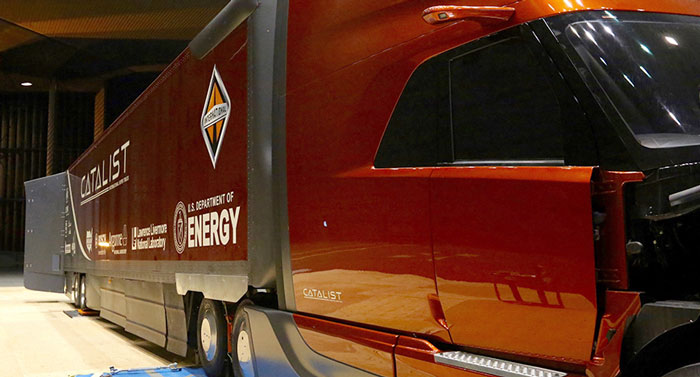Using science and technology to improve national energy security and surety, protect the environment, and understand and mitigate climate change
Laboratory researchers apply leading-edge capabilities to develop efficient and environmentally benign energy technologies and to investigate the processes behind climate change.
Helping the Paper Industry Save Energy and Reduce Costs
The U.S. paper-making industry ranks third among the nation’s largest energy users, behind only petroleum-refining and chemical production. Researchers from Lawrence Livermore and Lawrence Berkeley national laboratories are using their supercomputing capabilities to make paper production more energy efficient. The scientists are targeting “wet pressing,” the stage where water is removed by mechanical pressure from wood pulp. The effort leverages advanced simulation, high-performance computing (HPC), experimental measurements, and industry data to develop computer models that accurately simulate the wet-pressing process and thereby identify opportunities to save energy.
The paper-industry study, part of DOE’s High Performance Computing for Manufacturing (HPC4Mfg) Program, earned an HPC Innovation Excellence Award at SC17 in Denver, Colorado. HPC4Mfg provides opportunities for industry partners to access the HPC capabilities and expertise at DOE’s national laboratories for optimizing production processes to decrease energy consumption, enhancing product quality, and speeding design and testing cycles. LLNL has been the lead laboratory for the program, and with its success, DOE has launched the High Performance Computing for Materials (HPC4Mtls) Program, also led by Livermore.
Extracting Hydrogen from Water
Because it generates no carbon emissions, hydrogen is an attractive fuel source for many applications, including fuel cells. Laboratory scientists, working with colleagues from Rice University and San Diego State University, have developed a technique to extract hydrogen from water efficiently and cheaply by using a new class of catalysts based on inexpensive transition metals such as molybdenum and tungsten. Quantum mechanics simulations revealed particular material properties that could make catalysts far more efficient, and the research team computationally screened for candidate compounds. Experiments validated the effectiveness of two proposed catalysts, which performed better than expected. Today, splitting molecules to extract hydrogen from water using electricity is fairly straightforward but energy intensive, or requires expensive precious-metals catalysts.
Capturing Carbon Dioxide
Carbon dioxide (CO2) constitutes about 82 percent of total greenhouse gas emissions in the United States. Although CO2 is released through a variety of human activities, the biggest concern is CO2 emitted from large-scale sources such as power plants and industrial sites. Ideally, CO2 would be separated from power plant flue gas before leaving the smokestack and entering the atmosphere; but this process, known as carbon capture, is prohibitively expensive. A new Livermore separation technology relies on the recently discovered phenomenon of a reversible CO2 reaction in molten hydroxide. The technology involves a gas separation membrane containing molten hydroxide solution held in a porous material that selectively turns CO2 into carbonates.
Climate’s Impact on Snowpack
Laboratory researchers are deeply involved in studying climate change. An international team, including an LLNL scientist, found that human influence is responsible for up to 20 percent loss in the annual maximum amount of water contained in the Western United States’ mountain snowpack in the last three decades. Peak runoff in streams and rivers is strongly affected by melting of this snowpack. A significant decline in water has serious implications for hydropower, municipal, and agricultural sectors in the region. The team showed that the observed snowpack loss is consistent with results from climate simulations that included changes from natural factors and human influences.
In a separate study, an international team analyzed sediments eroded from the East Greenland ice sheet. They showed that over the past 7.5 million years the ice sheet has been dynamic and consistently responded to climate change. The team used LLNL’s Center for Accelerator Mass Spectrometry to analyze the sediments.
Bioengineered Bacteria Increase Rare Earth Supply
The rare earths comprise 17 elements in the periodic table, and many are essential to national security and U.S. industries. However, rare earths require extensive chemical processing to isolate individual elements. What’s more, greater than 90 percent of rare-earth elements come from China. To alleviate supply vulnerability and diversify the global supply chain, a Livermore-led team has developed a way to recover rare-earth elements using bioengineered bacteria. The outer cell walls of these bacteria feature binding tags containing molecules called ligands that exhibit 1,000 times greater affinity for rare earths than other metals. The new process makes mining for rare earths practical in nontraditional and low-value resources such as mine tailings, geothermal brines, and coal byproducts.







